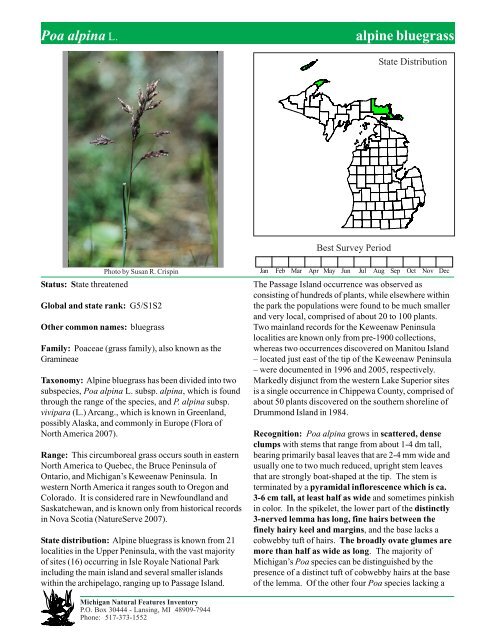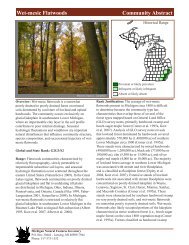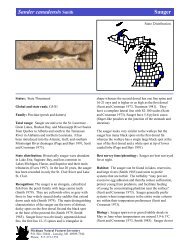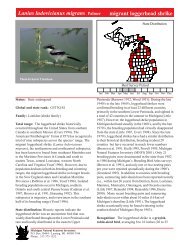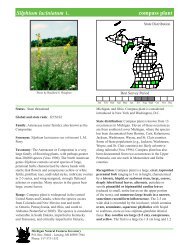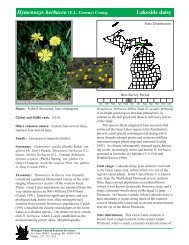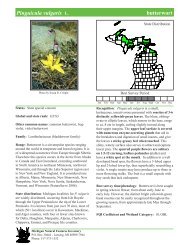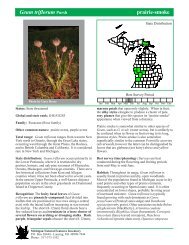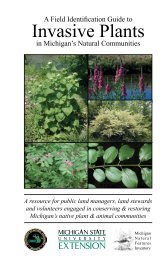Poa alpina - Michigan Natural Features Inventory - Michigan State ...
Poa alpina - Michigan Natural Features Inventory - Michigan State ...
Poa alpina - Michigan Natural Features Inventory - Michigan State ...
Create successful ePaper yourself
Turn your PDF publications into a flip-book with our unique Google optimized e-Paper software.
alpine bluegrass, Page 1<br />
<strong>Poa</strong> <strong>alpina</strong> L. alpine bluegrass<br />
Photo by Susan R. Crispin<br />
Status: <strong>State</strong> threatened<br />
Global and state rank: G5/S1S2<br />
Other common names: bluegrass<br />
Family: <strong>Poa</strong>ceae (grass family), also known as the<br />
Gramineae<br />
Taxonomy: Alpine bluegrass has been divided into two<br />
subspecies, <strong>Poa</strong> <strong>alpina</strong> L. subsp. <strong>alpina</strong>, which is found<br />
through the range of the species, and P. <strong>alpina</strong> subsp.<br />
vivipara (L.) Arcang., which is known in Greenland,<br />
possibly Alaska, and commonly in Europe (Flora of<br />
North America 2007).<br />
Range: This circumboreal grass occurs south in eastern<br />
North America to Quebec, the Bruce Peninsula of<br />
Ontario, and <strong>Michigan</strong>’s Keweenaw Peninsula. In<br />
western North America it ranges south to Oregon and<br />
Colorado. It is considered rare in Newfoundland and<br />
Saskatchewan, and is known only from historical records<br />
in Nova Scotia (NatureServe 2007).<br />
<strong>State</strong> distribution: Alpine bluegrass is known from 21<br />
localities in the Upper Peninsula, with the vast majority<br />
of sites (16) occurring in Isle Royale National Park<br />
including the main island and several smaller islands<br />
within the archipelago, ranging up to Passage Island.<br />
<strong>Michigan</strong> <strong>Natural</strong> <strong>Features</strong> <strong>Inventory</strong><br />
P.O. Box 30444 - Lansing, MI 48909-7944<br />
Phone: 517-373-1552<br />
Best Survey Period<br />
<strong>State</strong> Distribution<br />
Jan Feb Mar Apr May Jun Jul Aug Sep Oct Nov Dec<br />
The Passage Island occurrence was observed as<br />
consisting of hundreds of plants, while elsewhere within<br />
the park the populations were found to be much smaller<br />
and very local, comprised of about 20 to 100 plants.<br />
Two mainland records for the Keweenaw Peninsula<br />
localities are known only from pre-1900 collections,<br />
whereas two occurrences discovered on Manitou Island<br />
– located just east of the tip of the Keweenaw Peninsula<br />
– were documented in 1996 and 2005, respectively.<br />
Markedly disjunct from the western Lake Superior sites<br />
is a single occurrence in Chippewa County, comprised of<br />
about 50 plants discovered on the southern shoreline of<br />
Drummond Island in 1984.<br />
Recognition: <strong>Poa</strong> <strong>alpina</strong> grows in scattered, dense<br />
clumps with stems that range from about 1-4 dm tall,<br />
bearing primarily basal leaves that are 2-4 mm wide and<br />
usually one to two much reduced, upright stem leaves<br />
that are strongly boat-shaped at the tip. The stem is<br />
terminated by a pyramidal inflorescence which is ca.<br />
3-6 cm tall, at least half as wide and sometimes pinkish<br />
in color. In the spikelet, the lower part of the distinctly<br />
3-nerved lemma has long, fine hairs between the<br />
finely hairy keel and margins, and the base lacks a<br />
cobwebby tuft of hairs. The broadly ovate glumes are<br />
more than half as wide as long. The majority of<br />
<strong>Michigan</strong>’s <strong>Poa</strong> species can be distinguished by the<br />
presence of a distinct tuft of cobwebby hairs at the base<br />
of the lemma. Of the other four <strong>Poa</strong> species lacking a
cobwebby tuft at the lemma base, P. annua and P.<br />
autumnalis have five distinct lemma nerves, while P.<br />
compressa and P. canbyi have narrow inflorescences and<br />
lack long hairs between the keel and margin of the<br />
lemma.<br />
Best survey time/phenology: Most of the observations<br />
and collections of this species have occurred from early<br />
July through August, and flowering plants have been<br />
observed as early as mid-June. The optimal survey<br />
period for this species is thus estimated to be from mid-<br />
June through early September.<br />
FQI Coefficient and Wetland Category: 10, FACU<br />
Habitat: On Isle Royale’s shores, <strong>Poa</strong> <strong>alpina</strong> grows in<br />
basaltic rock crevices and along other wave-splashed,<br />
rocky shores where its associates include such species as<br />
Campanula rotundifolia (harebell), Potentilla tridentata<br />
(three-toothed cinquefoil), Trisetum spicatum (downy<br />
oatgrass), Euthamia graminifolia (grass-leaved<br />
goldenrod), Sagina nodosa (pearlwort), Polygonum<br />
viviparum (alpine bistort), Castilleja septentrionalis<br />
(pale Indian paintbrush), and Achillea millefolium<br />
(yarrow). On Passage Island it inhabits a disturbance<br />
opening and is concentrated along a footpath, growing in<br />
dense sod with Antennaria neglecta (pussytoes),<br />
Plantago major (common plantain), Fragaria<br />
virginiana (wild strawberry), and other native and<br />
adventive species. Although it thrives along rocky<br />
shores, alpine bluegrass may also occur along paths and<br />
elsewhere in interior areas under aspen and other<br />
overstory trees and or under shrubs such as Shepherdia<br />
canadensis (buffaloberry) and Physocarpus opulifolius<br />
(ninebark) or in open bearberry (Arctostaphylos uvaursi)<br />
– juniper (Juniperus spp.) heaths. Along the<br />
shoreline of Drummond Island, this species occurs on<br />
limestone in moist seepage areas with Trisetum spicatum<br />
and Carex scirpoidea (bulrush sedge). Elsewhere in its<br />
range it inhabits mostly calcareous subalpine and arctic<br />
habitats including alpine meadows, and also often occurs<br />
in disturbed ground (Flora of North America 2007).<br />
Biology: Alpine bluegrass is a tufted, low-growing<br />
perennial species. P. <strong>alpina</strong> subsp. vivipara, which is<br />
most common throughout northern and central Europe,<br />
is well known for its ability to reproduce asexually<br />
through the development of bulbiferous spikelets,<br />
producing spikelets that are either completely bulbiferous<br />
or those that are partly bulbiferous and partly flowering<br />
<strong>Michigan</strong> <strong>Natural</strong> <strong>Features</strong> <strong>Inventory</strong><br />
P.O. Box 30444 - Lansing, MI 48909-7944<br />
Phone: 517-373-1552<br />
alpine bluegrass, Page 2<br />
(Flora of North America 2007). Producing vegetative<br />
bulbs or plantlets in place of seeds is a reproductive<br />
approach demonstrated by certain arctic/alpine grass<br />
species, and can be considered a conservation strategy<br />
for retaining genetic traits developed by stress tolerators<br />
in low nutrient habitats (Pierce et al. 2003). Pierce as<br />
well as Baxter and Farrar (1999) and Baxter et al. (1997)<br />
found through detailed experiments that <strong>Poa</strong> <strong>alpina</strong> var.<br />
vivipara (and possibly var. <strong>alpina</strong>) actually lost<br />
photosynthetic capacity through long-term growth under<br />
elevated CO 2 conditions. Their findings indicate that<br />
global climate change may adversely affect alpine<br />
bluegrass, although the research thus far appears to have<br />
focused primarily on one subspecies.<br />
Conservation/management: The majority of the<br />
<strong>Michigan</strong> stations for this species are contained within<br />
Isle Royale National Park, where there are few threats,<br />
although protection of these sites from excessive foot<br />
traffic and human alteration of adjacent inland<br />
communities is advised. Searches of the Keweenaw<br />
Peninsula shoreline should be continued to relocate<br />
historical mainland localities. Inventories are also<br />
warranted elsewhere throughout the Upper Peninsula to<br />
identify additional new populations in calcareous bedrock<br />
shoreline areas, as this somewhat obscure grass species<br />
may be overlooked.<br />
Comments: <strong>Poa</strong> ×gaspensis Fernald is a rare hybrid<br />
between P. <strong>alpina</strong> and P. pratensis subsp. alpigena<br />
(Lindm.) Hiitonen, known only from the coastal<br />
mountains of the Gaspé Peninsula in Quebec, Canada<br />
(Flora of North American 2007). <strong>Poa</strong> <strong>alpina</strong> ecotypes<br />
and their origin as glacial relics were examined in an<br />
extensive paper by Turesson (1927).<br />
Research needs: In addition to inventories, the<br />
conservation and management of this species would<br />
benefit from basic life history studies, including research<br />
on population structure and genetic diversity.<br />
Related abstracts: Volcanic bedrock lakeshore, smallflowered<br />
wood rush, alpine bistort, pearlwort, encrusted<br />
saxifrage, prickly saxifrage, rayless mountain ragwort,<br />
squashberry
Selected references:<br />
Baxter, R. and J.F. Farrar. 1999. Export of carbon from<br />
leaf blades of <strong>Poa</strong> <strong>alpina</strong> L. at elevated CO 2 and<br />
two nutrient regimes. J. Exp. Botany 50: 1215-<br />
1221.<br />
Baxter, R., T.W. Ashenden, and J.F. Farrar. 1997.<br />
Effect of elevated CO 2 and nutrient status on<br />
growth, dry matter partitioning and nutrient<br />
content of <strong>Poa</strong> <strong>alpina</strong> var. vivipara L. J. Exp.<br />
Botany 48: 1477-1486.<br />
Flora of North America Editorial Committee. 2007.<br />
Flora of North America, North of Mexico.<br />
Volume 24: Magnoliophyta: Commelinidae (in<br />
part): <strong>Poa</strong>ceae, part 1. Oxford Univ. Press.<br />
New York, NY. 908 pp.<br />
Heide, O.M. 1989. Environmental control of flowering<br />
and viviparous proliferation in seminiferous and<br />
viviparous arctic populations of two <strong>Poa</strong> species.<br />
Arctic and Alpine Research 21: 305-315.<br />
NatureServe. 2007. NatureServe Explorer: an online<br />
encyclopedia of life [web application]. Version<br />
6.1. NatureServe, Arlington, Virginia. Available<br />
http://www.natureserve.org/explorer. (Accessed:<br />
October 15, 2007).<br />
Pierce, S., C.M. Stirling, and R. Baxter. 2003.<br />
Pseudoviviparous reproduction of <strong>Poa</strong> <strong>alpina</strong> var.<br />
vivipara L. (<strong>Poa</strong>ceae) during long-term exposure<br />
to elevated atmospheric CO 2 . Annals of Botany<br />
91: 613-622.<br />
Turesson, G. 1927. Contributions to the genecology of<br />
glacial relics. Hereditar 9: 81-101.<br />
Schlag, R.N. and B. Erschbamer. Germination and<br />
establishment of seedlings on a glacier foreland in<br />
the Central Alps, Austria. Arctic, Antarctic, and<br />
Alpine Research 32: 270277.<br />
Solhaug, K.A. 1991. Long day stimulation of dry matter<br />
production in <strong>Poa</strong> <strong>alpina</strong> along a latitudinal<br />
gradient in Norway. Holarct. Ecol. 14: 161-168.<br />
<strong>Michigan</strong> <strong>Natural</strong> <strong>Features</strong> <strong>Inventory</strong><br />
P.O. Box 30444 - Lansing, MI 48909-7944<br />
Phone: 517-373-1552<br />
Abstract citation:<br />
This project was funded, in part, by:<br />
The <strong>Michigan</strong> Coastal Management Program,<br />
<strong>Michigan</strong> Department of Environmental Quality<br />
and the<br />
alpine bluegrass, Page 3<br />
Penskar, M.R. 2008. Special Plant Abstract for <strong>Poa</strong><br />
<strong>alpina</strong> (alpine bluegrass). <strong>Michigan</strong> <strong>Natural</strong> <strong>Features</strong><br />
<strong>Inventory</strong>. Lansing, MI. 3 pp.<br />
Copyright 2008 <strong>Michigan</strong> <strong>State</strong> University Board of<br />
Trustees.<br />
<strong>Michigan</strong> <strong>State</strong> University Extension is an affirmativeaction,<br />
equal-opportunity organization.<br />
National Oceanic and Atmospheric Administration<br />
U.S. Department of Commerce


